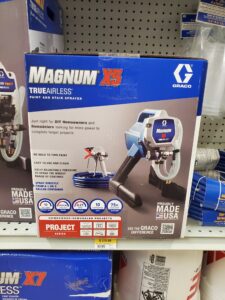No products in the cart.

Painting a fence can be a time-consuming and labor-intensive task. However, with the right tools and techniques, you can transform this chore into an enjoyable and efficient project. In this blog post, we’ll explore how paint sprayers can revolutionize your fence painting endeavors, offer you expert advice on choosing the best paint sprayer for fences, give you helpful fence painting tips, and information on maintaining your equipment for optimal results. Let’s dive in!
Choosing the Right Paint Sprayer for Fence Projects
When it comes to selecting the best paint sprayer for fences, there are two main types to consider: the Airless paint sprayer and the HVLP paint sprayer. Both offer unique advantages and are suited for different fence refinishing techniques.
Airless paint sprayers use high pressure to atomize paint, creating a smooth and even finish. This type of sprayer is ideal for large fence painting projects as it can cover vast surfaces quickly and efficiently. Airless sprayers also work well with a variety of paint types, including thicker protective coatings for fences.
HVLP (High Volume, Low Pressure) paint sprayers, on the other hand, use a low-pressure air stream to atomize paint. These sprayers are perfect for detail-oriented fence painting tasks, as they provide better control and minimize paint overspray. HVLP sprayers are best suited for thinner paint materials and smaller fence painting projects.
To choose the right paint sprayer for your fence project, consider factors such as the size of the area to be painted, the type of paint being used, and your desired level of control and precision.
Efficient Fence Painting: Tips for Using Paint Sprayers
Achieving a professional-quality finish with a paint sprayer requires some practice and preparation. Here are some essential fence painting tips to ensure your project goes smoothly:
By following these tips, you’ll be well on your way to achieving a beautiful and efficient fence painting result.
Maintaining Your Paint Sprayer for Optimal Fence Painting Results
To keep your paint sprayer in top working condition, it’s essential to perform regular paint sprayer maintenance. Proper care and upkeep will ensure that your equipment continues to deliver optimal performance, ultimately resulting in better fence refinishing outcomes. Here are some maintenance tips to keep your paint sprayer in peak condition:
By taking the time to properly maintain your paint sprayer, you’ll enjoy more efficient and effective fence painting results.
Advantages of Using Paint Sprayers for Fence Refinishing
There are several key benefits to using paint sprayers for fence refinishing projects. Some of these advantages include:
It’s time to “spray it, don’t say it,” and unleash the power of paint sprayers on your next fence project!
If you have more questions on your mind, we at Cat’s Claw Fasteners are here to help! Please forward your queries to our Head Cat Collector, Ralph, at ra***@***************rs.com. Be sure to explore our other blog posts and stay connected with us on Facebook, Instagram, Pinterest, and Youtube!
Read Next: The Best Plants To Grow on Your Fence Line

© 2024 Cat's Claw Fasteners, LLC | All Rights Reserved - Built by Redemptive Software